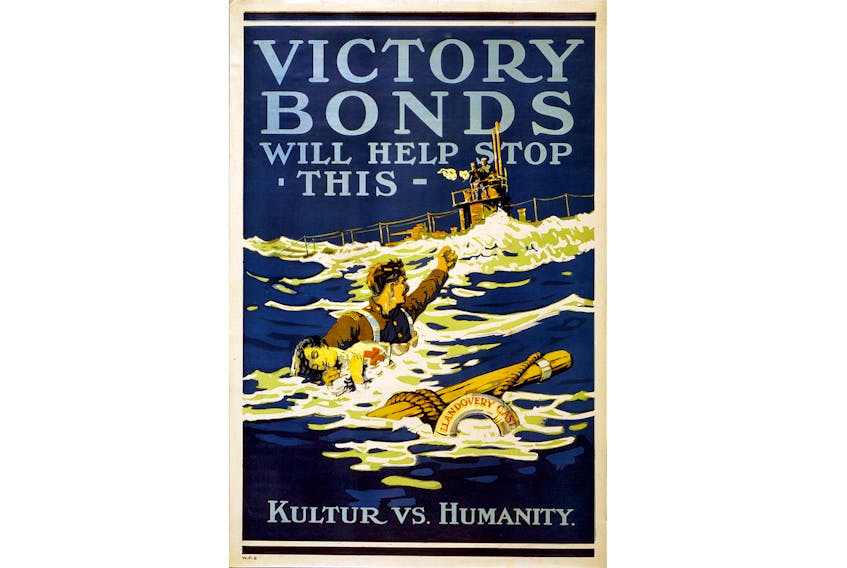The daughter of a prominent New Glasgow family was one of 14 Nursing Sisters who perished at sea 100 years ago, when a German U-boat sank a Canadian Army Medical Corps (CAMC) hospital ship off the coast of Ireland.
Margaret Marjorie “Pearl” Fraser was the daughter of Duncan Cameron “D. C.” and Elizabeth “Bessie” (Graham) Fraser. D.C. served as Mayor of New Glasgow during the 1880s before entering federal politics as the Member of Parliament for Guysborough, a position he held from 1891 to 1904. He subsequently served on the Nova Scotia Supreme Court for two years before being appointed Lieutenant Governor of Nova Scotia, a position he held until his untimely death on Sept. 27, 1910, at the age of 64 years.
By the time of her father’s passing, Pearl had completed a nursing training program at an Ottawa school and by 1912 was employed as a Head Nurse at Vancouver General Hospital. Following the outbreak of war in early August 1914, she travelled to Quebec City and enlisted with the CAMC. She crossed to England with the First Canadian Contingent in October 1914 and was selected for duty in France shortly after arriving overseas.
On Nov. 1, 1914, Pearl crossed the English Channel with No. 2 Canadian Stationary Hospital (CSH), which established a facility at Le Touquet, near Étaples, France. While she served with the unit for 15 months, like many of her CAMC comrades, Pearl sought to work as close to the front as possible. In February 1916, she received a transfer to No. 2 Canadian Casualty Clearing Station (CCS) in February 1916.
Casualty-clearing stations received casualties directly from field ambulances that operated immediately behind the front trenches. The units represent the limit of nursing sister service in the forward area. German aircraft occasionally conducted bombing raids on the communities where they were located and the sound of artillery fire was clearly audible.
At the time of Pearl’s transfer, the No. 2 CCS was located at Aire-sur-la Lys, near Béthune France, and the Belgian frontier. In mid-November 1916, its personnel relocated to Remy Siding, on the outskirts of Ypres, Belgium. Pearl served with the unit throughout the winter of 1916-17. By the spring of the year, having logged two and a half years’ service in France and Belgium, it was time for a change. On May 10, 1917, Pearl was posted to HMHS Letitia, one of several hospital ships transporting sick and wounded Canadian soldiers home.
With the exception of a brief period at an English hospital in late summer 1917, Pearl served on the hospital ships into the following year, making several crossings on the Araguaya during the autumn and winter of 1917-18. The vessel was the CAMC fleet’s “work horse,” completing 20 trans-Atlantic crossings and carried more than 15,000 wounded Canadian soldiers home by war’s end.
Pearl’s two brothers also enlisted for overseas service, receiving the commissioned rank of Lieutenant. Alistair initially served with the 15th Battalion (48th Highlanders of Canada) in France and was wounded at Vimy Ridge on April 9, 1917. Invalided to England, he subsequently received the Military Cross for his performance during the historic battle and occupied several administrative posts. James Gibson Laurier, the youngest of the five Fraser children, commenced service in France with the 16th Battalion (Canadian Scottish) in May 1917.
On March 4, 1918, Lt. Laurier Fraser was killed by artillery fire near Mazingarbe, France. News of their brother’s death had a significant impact on his siblings. Alistair immediately relinquished his duties as aide de camp to Lt. General Sir Arthur Currie. While Pearl was officially appointed Acting Matron of the hospital ship Llandovery Castle on March 22, 1918, she received one month’s sick leave three weeks later.
Pearl returned to duty on May 17, 1918, and may have made a voyage to Canada aboard the Llandovery Castle in late May, early June. Whatever the case, she was aboard the vessel when it docked at Halifax on June 17, with a total of 644 patients on board. Three days later, the Llandovery Castle departed for England, its CAMC staff of 97 and the vessel’s crew the only passengers on board.
It was a pleasant summer voyage, the medical personnel taking the opportunity to relax on deck during fine weather. On the evening of June 27, 1918, the Llandovery Castle was approximately 190 kilometres west of Fastnet Rock, off Ireland’s southern tip, when a German U-boat spotted the vessel.
At 9:30 p.m., without prior warning, the U-boat fired a torpedo, striking the ship “abaft” of its No. 4 engines. The resulting explosion destroyed a large portion of the stern and disabled its engines. Virtually all engine room personnel were killed or wounded and the Captain on the bridge lost all control over the vessel.
In response, the Captain ordered all aboard to abandon ship. The CAMC staff and remaining crew immediately assembled at their assigned lifeboat stations. All 14 Nursing Sisters climbed into one boat, under the direction of Sergeant Arthur Knight, one of a handful of CAMC personnel destined to survive the ordeal. In later testimony, Knight described the ensuing events.
While the lifeboat carrying the Nursing Sisters dropped to the water, the two ropes attaching it to the vessel failed to release. Sgt. Knight broke two axes while attempting to cut the ropes. Meanwhile, passengers used the oars to prevent the boat from smashing against the sinking vessel’s hull, breaking all in the process. The ropes finally released, but the boat drifted helplessly alongside the sinking ship.
Shortly afterward, a large section of the stern fell into the water, creating a vortex into which the nursing sisters’ lifeboat was drawn. As it entered the whirlpool, the boat capsized, throwing its occupants into the sea. While Knight managed to surface three times and was finally able to cling to a piece of debris, Acting Matron Pearl Fraser and her Nursing Sister colleagues perished as the waters consumed the lifeboat.
Within 10 minutes off being struck, the Llandovery Castle slipped beneath the waters. A total of 234 CAMC and vessel crew perished in the incident. Of the 24 passengers who managed to escape the debris field in two lifeboats, only one CAMC Officer and five “other ranks” survived the ordeal.
Acting Matron Margaret Marjorie Fraser’s name and those of her CAMC comrades are engraved on a Commonwealth War Graves Commission memorial plaque erected at Point Pleasant Park, Halifax, in November 1967. The monument contains the names of Army, Navy and Merchant Marine personnel lost at sea during the First and Second World Wars. Numerous other memorials commemorate the loss of the Llandovery Castle’s 14 Nursing Sisters. Shortly after the war’s conclusion First Presbyterian Church, New Glasgow, installed stained glass windows in memory of Pearl and her brother, Laurier.
Bruce MacDonald is author of First World War Honour Roll of Guysborough County Nova Scotia. A more detailed version of Pearl Fraser’s story is available online at guysboroughgreatwarveterans.blogspot.com.









